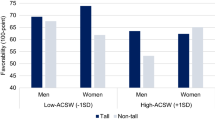Abstract
The question of whether or not life success halo effects occur for weight for Black and White women was examined in an experiment using a 2 (race of woman) × 2 (weight of woman) × 2 (sex of participant) design and measures of perceived life success, attractiveness, and personality. The thinner White woman was expected to receive higher life success, attractiveness, and personality ratings than the heavy White woman. However, the heavy Black woman was expected to receive higher ratings than the thinner Black woman. The results were consistent with expectations. These results are discussed in terms of prior research on beauty, weight, and stereotyping.
Similar content being viewed by others
REFERENCES
Cohn, L. D., & Adler, N. E. (1992). Female and male perceptions of ideal body shapes: Distorted views among Caucasian college students. Psychology of Women Quarterly, 16, 69-79.
Crago, M., Shisslak, C. M., & Estes, L. S. (1996). Eating disturbances among American minority groups: A review. International Journal of Eating Disorders, 19, 239-248.
Cunningham, M. R., Roberts, A. R., Barbee, A. P., Druen, P. B., & Wu, C.-H. (1995). "Their ideas of beauty are, on the whole, the same as ours": Consistency and variability in the cross cultural perception of female physical attractiveness. Journal of Personality and Social Psychology, 68, 261-279.
Devine, P. G. (1989). Stereotypes and prejudice: Their automatic and controlled components. Journal of Personality and Social Psychology, 56, 5-18.
Dion, K., Berscheid, E., & Walster, E. (1972). What is beautiful is good. Journal of Personality and Social Psychology, 24, 285-290.
Frieze, I. H., Olson, J. E., & Russell, J. (1991). Attractiveness and income for men and women in management. Journal of Applied Social Psychology, 21, 1039-1057.
Harris, M. B., & Smith, S. D. (1983). The relationships of age, sex, ethnicity, and weight to stereotypes of obesity and self perception. International Journal of Obesity, 7, 361-371.
Larkin, J. C., & Pines, H. A. (1979). No fat persons need apply, experimental studies of the overweight stereotype and hiring preference. Sociology of Work and Occupations, 6, 312-327.
Monello, L. F., & Mayer, J. (1963). Obese adolescent girls. American Journal of Clinical Nutrition, 13, 35-39.
Parham, T. A., White, J. L., & Adjamu, A. (1999). The psychology of Blacks: An African centered perspective (3rd ed.). Upper Saddle River, NJ: Prentice-Hall.
Parker, S., Nichter, M., Nichter, M., Vuckovic, N., Sims, C., & Rittenbaugh C. (1995). Body image and weight concerns among African-American and White adolescent females: Differences that make a difference. Human Organization, 54, 103-113.
Powell, A. D., & Kahn, A. S. (1995). Racial differences in women's desires to be thin. International Journal of Eating Disorders, 17, 191-195.
Rothblum, E. D. (1992). The stigma of women's weight: Social and economic realities. Feminism and Psychology, 2, 61-73.
Venes, A. M., Krupka, L. R., & Gerard, R. J. (1982). Overweight/obese patients: An overview. The Practitioner, 226, 1102-1109.
Wade, T. J. (1997, October). Evolutionary theory and African American self-perception: Sex differences in body esteem predictors of physical and sexual attractiveness and self-esteem. Paper presented at the Ford Foundation Minority Scholars Convention, National Academy of Sciences, Washington, DC.
Wade, T. J. (2000). Evolutionary theory and self-perception: Sex differences in the relationships between self-perceived physical and sexual attractiveness, self-esteem, and body esteem. International Journal of Psychology, 35, 36-45.
Wade, T. J. Loyden, J., Renninger, L., & Tobey, L. (2003). Weight halo effects: Differences in personality evaluations as a function of weight? Personality and Individual Differences, 34, 263-268.
Wildes, J. E., Emery, R. E., & Simons, A. D. (2001). The roles of ethnicity and culture in the development of eating disturbance and body dissatisfaction: A meta-analytic review. Clinical Psychology Review, 21, 521-551.
Author information
Authors and Affiliations
Corresponding author
Rights and permissions
About this article
Cite this article
Wade, T.J., DiMaria, C. Weight Halo Effects: Individual Differences in Perceived Life Success as a Function of Women's Race and Weight. Sex Roles 48, 461–465 (2003). https://doi.org/10.1023/A:1023582629538
Issue Date:
DOI: https://doi.org/10.1023/A:1023582629538



